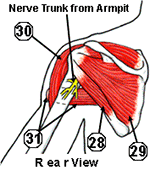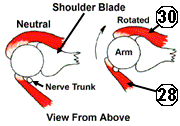 Teres Minor (28) is made more hypertonic than Infraspinatus (29) by being attached further from the pivot point of the arm bone. Its biggest threat is its position to entrap a nerve trunk. Both contracting 29 to reach behind you and stretching 28 to reach forward will bring these hardened contracted muscles in contact with the nerve trunk. Teres Minor (28) is made more hypertonic than Infraspinatus (29) by being attached further from the pivot point of the arm bone. Its biggest threat is its position to entrap a nerve trunk. Both contracting 29 to reach behind you and stretching 28 to reach forward will bring these hardened contracted muscles in contact with the nerve trunk.
The front portion of the deltoid, or Anterior Deltoid (30), is used to reach forward and to rotate the humerus (upper arm bone) as seen in the Figure below. In rotation, you can see how the nerve trunk is dragged under the spastic 28. This is why the term "Rotator Cuff" (usually referring to the Supraspinatus muscle) has become the "scape goat" for this unrecognized nerve entrapment.
Since 30 acts as an opposing muscle to 28 , there are special coordinating nerve connections between the two. Whenever 30 pulls 28 into the nerve trunk, 28 can cause 30 to "freeze" so as not to pull further. This, over time, causes 30 to develop hypertonicity also. The pain caused by the "freezing" of 30 is usually more conscious than the pain caused by 28 entrapping the nerve trunk. In extreme cases, this scenario results in a frozen shoulder.
 30 has an attachment adjacent to Pectoralis Major (31), the pectoral muscle running chest to arm. This can lead to chest and arm pain that simulates heart pain. 30 has an attachment adjacent to Pectoralis Major (31), the pectoral muscle running chest to arm. This can lead to chest and arm pain that simulates heart pain.
Pulse 28, 29, 30, and 31.
|

